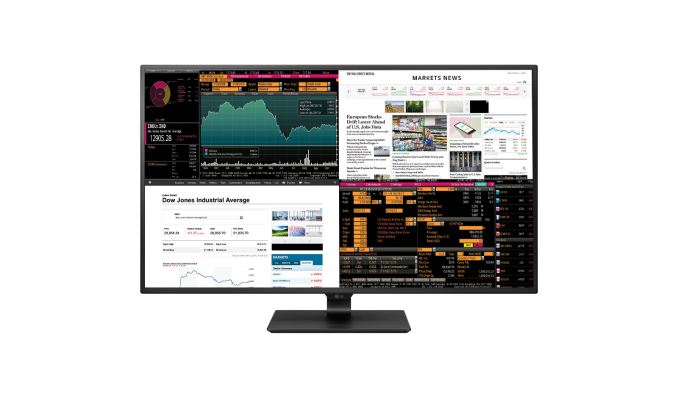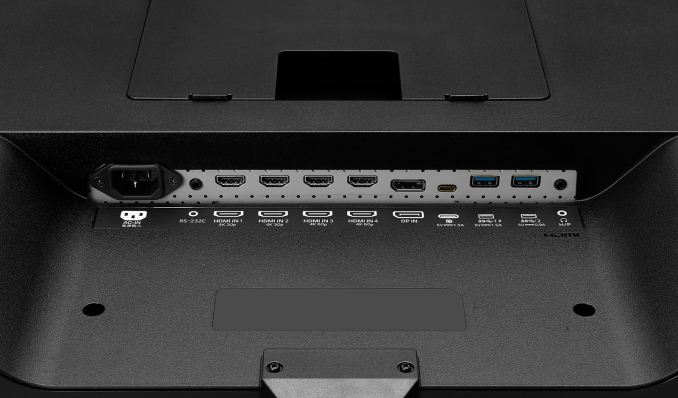LG 43UD79-B Launched: 42.5-inch 4K IPS with FreeSync
by Patrick MacMillan on May 1, 2017 2:01 PM EST
LG is about to launch a new monitor that is one of the most feature-filled monitors on the market once it arrives. Referred to as the 43UD79-B, this 42.5-inch display has a native UHD resolution of 3840 x 2160 with a conventional refresh rate of 60Hz. It features an IPS panel with a non-glare coating, a peak brightness of 350 cd/m2, a contrast ratio of up to 1000:1, and an 8ms gray-to-gray (GTG) response time. The viewing angles are wide at 178°/178°, which is typical for an IPS display. Although support for 1.07 billion colors is claimed, the lack of an explicit mention of a 10-bit panel leads us to believe that this is an 8-bit panel using A-FRC to achieve a 10-bit color depth. On the plus side, this model will ship color calibrated from the factory.
| Specifications | |||
| LG 43UD79-B | |||
| Panel | 42.5" IPS | ||
| Resolution | 3840 × 2160 | ||
| Refresh Rate | 60 Hz | ||
| Variable Refresh Rate | FreeSync | ||
| Response Time | 8 ms (GTG) | ||
| Brightness | 350 cd/m² | ||
| Contrast | Up to 5000000:1 1000:1 Typical |
||
| Viewing Angles | 178°/178° horizontal/vertical | ||
| PPI | 104 pixels per inch 0.245 mm2 pixel pitch |
||
| Colors | 1.07 billion | ||
| Inputs | 1 × DisplayPort 1.2a 2 × HDMI 2.0 2 × HDMI 1.4 1 × USB Type-C with DP Alt Mode 1 × RS-232C |
||
| USB Hub | 2-port USB 3.0 hub with KVM Functionality | ||
| Audio | 2 × 10W harmon/kardon speakers Headphone Output |
||
| Launch Date | May 19th, 2017 (Japan) | ||
| Launch Price | ¥83000 (Japanese Yen) ~$745 USD |
||
Assuming that the press release is indeed accurate, this model not only supports FreeSync variable refresh technology, but also a host of other gaming-oriented features like Game Mode, Black Stabilizer, and Dynamic Action Sync (DAS) Mode. The native 60Hz refresh rate will likely preclude this model from ever becoming a gamer favorite, but we are still glad to see that LG made an effort in catering to the gaming crowd. The peak refresh rate is likely 60 Hz for the Freesync, however LG does not specify the lower bound. Technically the specification sheet says 56-61Hz, although that is rather small for a FreeSync range.
The connectivity front is where this monitor really shines. There are two HDMI 2.0 inputs (4K @ 60Hz), two HDMI 1.4 inputs (4K @ 30Hz), one USB 3.1 Type-C port that can operate in DP Alt Mode and thus carry a DisplayPort signal, and one DisplayPort 1.2a input (4K @ 60Hz) that supports the aforementioned FreeSync feature. The reason for all these inputs is that this monitor can display images from up to 4 devices at once. You can either split the screen into four 21.5-inch 1080P sections, two horizontal or vertical sections, or even three sections of varying sizes. There is also support for basic Picture-in-Picture (PIP) if you don't wish to subdivide the screen real estate.

Different monitor arrangements with multiple inputs
Also present is LG's Dual Controller feature, which essentially turns the monitor into a KVM switch. Users can plug a mouse and keyboard into the two downstream USB 3.0, install the Dual Controller software on two systems, and control both of them from that single mouse/keyboard combo. Rounding out the basic specifications are built-in 2x10W Harman Kardon stereo speakers, a headphone jack, an RS-232C connector, and a small remote control. The included stand is fairly basic in that it only allows tilt adjustments.
While the press release indicates a countrywide Japanese launch on May 19th at a price of around 83,000 yen, US-based retailers are already offering preorders for $697 with an expected availability of May 9th. If that holds true, that is a very attractive price for a roughly 43-inch 4K monitor with that many built-in features and a three-year warranty.
Source: LG


















46 Comments
View All Comments
mmrezaie - Monday, May 1, 2017 - link
I think Philips has the same panel and a little bit cheaper in my region. I wonder if anyone has a good experience with these 40" 4k monitors. I had 27" 4k and I would like my 4k monitor to be bigger. like 50% and this seems like an ideal one.nikaldro - Monday, May 1, 2017 - link
A 40" is over twice as big as a 27"mmrezaie - Monday, May 1, 2017 - link
50% * 27 = 14 + 27 ~ 40!ajp_anton - Monday, May 1, 2017 - link
27" area: 312 square inches.40" area: 684 square inches.
40" is 2.2 times bigger.
Candyhands - Monday, May 1, 2017 - link
It's actually 219% the size of a 27 inch, so more than twice the size. Follow this link https://goo.gl/3xpRv1mmrezaie - Monday, May 1, 2017 - link
Thank you all. But I was referring to the width. Since I only care how much I have to turn my head to see the left and right sides of the monitor.XabanakFanatik - Monday, May 1, 2017 - link
The width of a monitor is not the same as its diagonal size, which is used for the advertised size. A 16:9 27" display is 23.5 inches wide, and a 40" 16:9 display is 34.9 inches wide.Fortunately, 34.9 is about 50% larger than 23.5, as well.
boozed - Monday, May 1, 2017 - link
XabanakFanatik: Because they're the same aspect ratio, it doesn't matter which linear measurement you compare. The proportional difference will be the same.mbarr - Monday, May 1, 2017 - link
I've been using the 43" 4k Philips equivalent for several months and it is brilliant! See http://www.philips.com.au/c-p/BDM4350UC_75/brillia...This LG model appears to be the same panel given its specs, but has additional features such as KVM over the USB ports and 10W instead of 7W speakers.
I bought this 43" 4k monitor after feedback from a colleague who specially bought a Sony 42" TV for use as a monitor, and he is right; It is comfortable to use as a large monitor. It is like having four 24" monitors without bezels between them. I bought it for 3D design because it gives me a viewing area which doesn't cross over a bezel and lets me zoom in on vertices to easily select them. Unlike a curved screen this flat panel means my lines appear straight.
Yes, the sides of the screen don't point straight at me, but it also means I can view entire drop-down menus without scrolling. I had an expensive high quality adjustable VESA mount which I gave away after buying this monitor because I simply didn't need it anymore. It surprised me that the non-adjustable feet, which only lifted the monitor several cm's above my desk, turned out to be just right. In the past I have positioned monitors so the top of the viewable area is at eye-height to optimise ergonomics. Now, I find my eyes are only somewhat above centre but it works so well.
Opening Microsoft Word on this monitor lets me display six A4 pages in larger than 100% of actual size, so long as I don't mind a little bit of each page cut-off at the top and bottom. It is great for comparing what I'm typing with what I typed a few pages ago. I can also scale pages up so large that I don't need glasses, and that's without pixelation.
I can stretch a spreadsheet really wide on the top half, whilst working on another document on the bottom half, each effectively two monitors wide. Similarly I can have email on one side and the WWW open on the other, each two monitors high. For instance my boy likes to play Roblox on one side whilst watching youtube on the other side.
I go into work where I have dual 22" monitors and don't have any problem adjusting up or down. On the other hand I appreciate my 43" 4k monitor nearly every time I see it. Its a bit like my car in that respect. Its a point of pride.
quantcon - Thursday, May 4, 2017 - link
"Fortunately, 34.9 is about 50% larger than 23.5, as well."It's not "fortunate". Any corresponding linear measurement will preserve the scale-up ratio. Ex. you could measure a line segment at an angle X degrees from the bottom edge in both, and it will still be 50% larger.